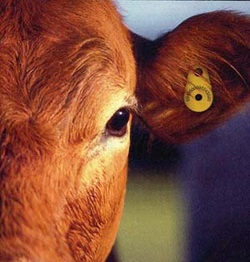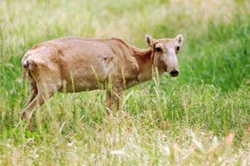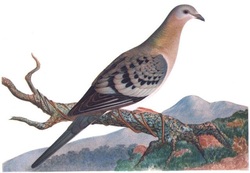Coextinction: A cause to extinction
Coextinction refers to the loss of a species due to the extinction of another; for example, the extinction of parasitic insects following the loss of their hosts. Coextinction can also occur when a species loses its pollinator, or to predators in a food chain who lose their prey. "Species coextinction is a manifestation of the interconnectedness of organisms in complex ecosystems ... While coextinction may not be the most important cause of species extinctions, it is certainly an insidious one". Coextinction is especially common when a keystone species goes extinct.
Predation, competition, and disease

livestock
Before the evolution of hominids, life forms competed with each other and drove one another extinct. Recently in geologic time, Humans have been transporting animals and plants from one part of the world to another for thousands of years, sometimes deliberately (e.g., livestock released by sailors onto islands as a source of food) and sometimes accidentally (e.g., rats escaping from boats). In most cases, such introductions are unsuccessful, but when they do become established as an invasive alien species, the consequences can be catastrophic. Invasive alien species can affect native species directly by eating them, competing with them, and introducing pathogens or parasites that sicken or kill them or, indirectly, by destroying or degrading their habitat. Human populations may themselves act as invasive predators. According to the "overkill hypothesis", the swift extinction of the megafauna in areas such as New Zealand, Australia, Madagascar and Hawaii resulted from the sudden introduction of human beings to environments full of animals that had never seen them before, and were therefore completely unadapted to their predation techniques.

Purebred wild species evolved to a specific ecology can be threatened with extinction through the process of genetic pollution—i.e., uncontrolled hybridization, introgression genetic swamping which leads to homogenization or out-competition from the introduced (or hybrid) species. Endemic populations can face such extinctions when new populations are imported or selectively bred by people, or when habitat modification brings previously isolated species into contact. Extinction is likeliest for rare species coming into contact with more abundant ones; interbreeding can swamp the rarer gene pool and create hybrids, depleting the purebred gene pool (for example, the endangered Wild water buffalo is most threatened with extinction by genetic pollution from the abundant domestic water buffalo). Such extinctions are not always apparent from morphological (non-genetic) observations. Some degree of gene flow is a normal evolutionarily process, nevertheless, hybridization (with or without introgression) threatens rare species' existence.
The gene pool of a species or a population is the variety of genetic information in its living members. A large gene pool (extensive genetic diversity) is associated with robust populations that can survive bouts of intense selection. Meanwhile, low genetic diversity (see inbreeding and population bottlenecks) reduces the range of adaptions possible. Replacing native with alien genes narrows genetic diversity within the original population, thereby increasing the chance of extinction.
Genetics and demographic phenomena

Population genetics and demographic phenomena affect the evolution, and therefore the risk of extinction, of species. Limited geographic range is the most important determinant of genus extinction at background rates but becomes increasingly irrelevant as mass extinction arises.
Natural selection acts to propagate beneficial genetic traits and eliminate weaknesses. It is nevertheless possible for a deleterious mutation to be spread throughout a population through the effect of genetic drift.
A diverse or deep gene pool gives a population a higher chance of surviving an adverse change in conditions. Effects that cause or reward a loss in genetic diversity can increase the chances of extinction of a species. Population bottlenecks can dramatically reduce genetic diversity by severely limiting the number of reproducing individuals and make inbreeding more frequent. The founder effect can cause rapid, individual-based speciation and is the most dramatic example of a population bottleneck.
Causes for Extinction

As long as species have been evolving, species have been going extinct. It is estimated that over 99% of all species that ever lived have gone extinct. The average life-span of most species is 10 million years, although this varies widely between taxa. There are a variety of causes that can contribute directly or indirectly to the extinction of a species or group of species. "Just as each species is unique," write Beverly and Stephen Stearns, "so is each extinction ... the causes for each are varied—some subtle and complex, others obvious and simple". Most simply, any species that is unable to survive or reproduce in its environment, and unable to move to a new environment where it can do so, dies out and becomes extinct. Extinction of a species may come suddenly when an otherwise healthy species is wiped out completely, as when toxic pollution renders its entire habitat unliveable; or may occur gradually over thousands or millions of years, such as when a species gradually loses out in competition for food to better adapted competitors. Extinction may take place a long time after the events that set it in motion, a phenomenon known as extinction debt.
Assessing the relative importance of genetic factors compared to environmental ones as the causes of extinction has been compared to the nature-nurture debate. The question of whether more extinctions in the fossil record have been caused by evolution or by catastrophe is a subject of discussion; Mark Newman, the author of Modeling Extinction argues for a mathematical model that falls between the two positions. By contrast, conservation biology uses the extinction vortex model to classify extinctions by cause. When concerns about human extinction have been raised, for example in Sir Martin Rees' 2003 book Our Final Hour, those concerns lie with the effects of climate change or technological disaster.
Currently, environmental groups and some governments are concerned with the extinction of species caused by humanity, and are attempting to combat further extinctions through a variety of conservation programs. Humans can cause extinction of a species through overharvesting, pollution, habitat destruction, introduction of new predators and food competitors, overhunting, and other influences. Explosive, unsustainable human population growth is an essential cause of the extinction crisis. According to the International Union for Conservation of Nature (IUCN), 784 extinctions have been recorded since the year 1500 (to the year 2004), the arbitrary date selected to define "modern" extinctions, with many more likely to have gone unnoticed (several species have also been listed as extinct since the 2004 date).




 RSS Feed
RSS Feed